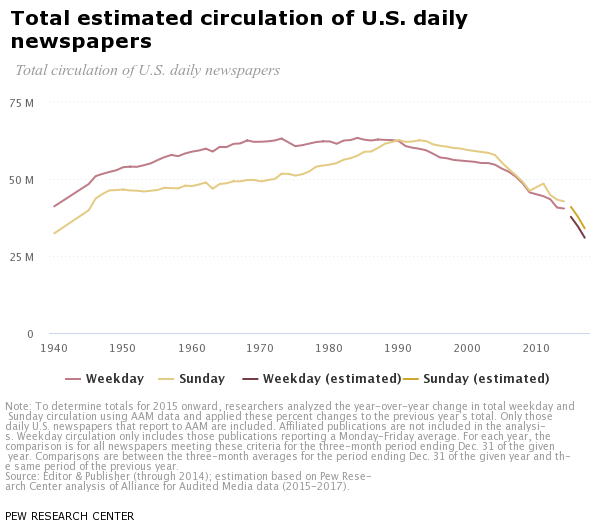
Let the Power of Google Ads Do Your Marketing Heavy Lifting
September 27, 2018
Leverage Your LinkedIn Profile With These 5 Tips
January 25, 2019In a previous blog, 5 Signs Digital Marketing is Replacing Traditional Media, we wrote about the signs of the digital marketing transformation unfolding around us. From disappearing office addresses to uber thin fonts and interactive documents, all the signposts were telling us that marketing as we knew it was being upended. What began as a slow and steady stream of changes has become a rising flood that has now enveloped the media landscape in its entirety.
As the sea change continues, we thought we would share 5 MORE signs digital marketing is replacing traditional media.
1. Digital ads overtake television ad spend
In 2017, digital ad spending in the US surpassed traditional TV ad expenditures for the first time–much of the shift driven by mobile. In fact, eMarketer projects, “By 2020, [mobile] will represent 43% of total media ad spending in the US—a greater percentage than all traditional media combined.” As Millennials, in particular, migrate to video and online streaming of their favorite programming, digital ads give marketers the platform and versatility to target them. Traditional television ads are comparatively random in their audience reach, and overall television viewership is declining in the United States as well. A study by Omnicom Media Group found that “…in 2016 the smartphone replaced the TV as the device most watched by Millennials,” and there’s even a new marketing nickname for the 22 to 35-year-old demographic that eschews traditional television–the Unreachables.

2. Newspaper circulations decline sharply
The recent Pew Research Center Newspapers: Fact Sheet notes that the estimated total circulation of U.S. daily newspapers has fallen precipitously since the early 1990s. The decline extends to both Sunday and weekday circulations. By the numbers, total estimated circulation of U.S. newspapers halved to circa 31 million in 2017 from 62 million in 1990.
Although digital newspaper circulations are not easy to gauge, the estimated number of unique visitors to the top 50 U.S. online newspaper sites appeared stable in 2017 and saw double-digit gains both in 2016 and 2015. The growth in digital newspaper readership is in sharp contrast to the trend in physical newspaper circulation.
3. Not just office addresses, but offices disappear
Remote working is here to stay. Not only are more employees working remotely, but they are spending longer periods of time engaged in remote work as well. In Freelancing in America 2018, Upwork noted that 56.7 million Americans, or 35% of the workforce, now freelance, and the number of Americans that are freelancing has increased by 3.7 million people since 2014. As the freelancing revolution takes hold, multi-channel digital marketing is adept at targeting a mobile labor force used to working in different spaces, on multiple devices, and in the cloud.
“Audiences continue to abandon traditional media, and ad dollars follow.” –eMarketer
4. Business cards fall by the wayside
I recently attended a business dinner with 15 other marketing professionals, C-Suite executives, and startup co-founders. When I asked a few attendees for business cards, each had the same response–I don’t carry business cards anymore. One person told me his company did not want to pay for physical business cards. The digital age has ushered in the concept of “connecting,” and in fact, after dinner, several people connected with me on LinkedIn. There are also numerous business card apps so people can exchange their contact information digitally. It is estimated that 88% of physical business cards are thrown away within one week of people receiving them which explains why even marketing oneself has gone digital.
5. Digital ads use keywords to identify potential customers
According to Google Benchmarks and Insights, Google display campaigns–image-based digital ads–reach 80% of global internet users. Not only do Google Ads have incredible reach, but they have sophisticated, data-driven audience targeting tools. The ads are driven in part by keywords, words or phrases relevant to an Internet search. These keywords are one component of the algorithmic calculation that determines relevance, a critical metric that forms the basis for which digital ads a person sees.
Broadly categorized into three types, keywords help digital marketers identify and hone in on specific stages of the buyer’s journey with a level of precision not possible using traditional media. Briefly,
- Navigational keywords go to a certain website or destination, often a company name or brand
- Informational keywords help the user acquire information (how to, compare, information about)
- Transactional keywords prompt action (buy, get, contact, sign up)
Based on cues such as keywords, digital marketers can efficiently fashion ads for the multi-stage buyer’s journey and optimize the audiences that see the ad.
So, there you have 5 MORE signs digital marketing is replacing traditional media. At Resourceful Business, we continue to evolve our marketing strategies to respond to the rapidly changing marketing landscape and the challenges that accompany it.
If you’re interested in learning more about how digital marketing can grow your business, please contact us.





2 Comments
thanks for this informative sharing. helpful one. keep it up.
Great info. Thanks!
https://youtu.be/mx7tL7qO4jM